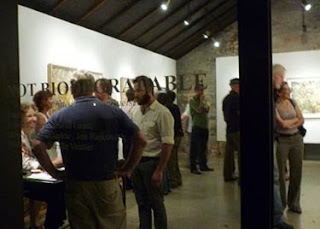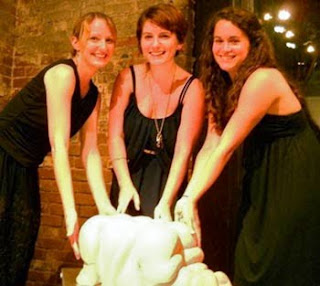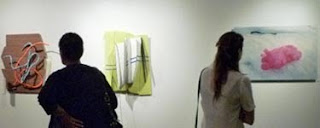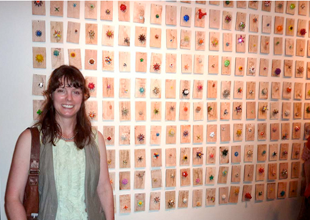On August 21st, curator Leslie Kneisel held an informal conversation at the gallery. She discussed some of her inspiration for the current whitespace exhibit Not Biodegradable, as well as ideas and her thoughts behind the artwork she chose. We wanted to share with you a few of the highlights from her talk.
An artist in her own right, Leslie has exhibited her work in Atlanta since 1985. She considers Not Biodegradable her personal “contribution to the community.” With this exhibit she hopes to bring a “new direction and dialogue” to the Atlanta art community by showing a glimpse of the LA scene to Atlanta. In her observation of LA artists, Leslie became intrigued with how many seem to be process and material oriented, creating art that is more concerned with light, color and materials and less concept driven.
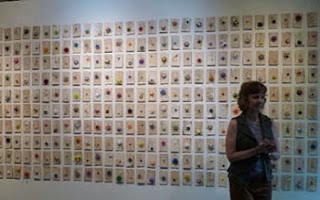 |
| Curator Leslie Kniesel in front of “Mother Board” by Alison Foshee. |
Curatorial Inspiration – The Bear Story & Art that Endures
The roots for Not Biodegradable germinated in two experiences.
On a camping trip last spring, a tattered plastic bag caught Leslie’s eye while she was speaking with the camp director. The director stopped her from picking it up. Its presence was to serve as an example of what remains after the campers and the bears have left the campground.
Plastic’s longevity merged with Leslie’s thoughts regarding a discussion that participating artist Mery Lynn McCorkle had about whether to create art that disintegrates or art that endures and is “permanent.”
Created from a clay mold, David Grant’s latex sculptures are rooted in the homosexual subculture of “gainers.” (please see entry dated August 11, 2010) Yet, Grant’s touch of silliness, irreverence, bravado and eye for color invite the viewer to touch. As Leslie exclaimed: “Squooshy! DO TOUCH!”
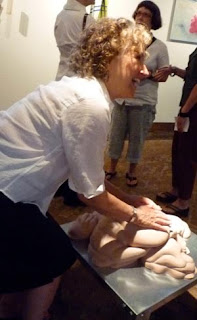 |
| Director Susan Bridges DOES Touch! |
Through her luminous mixed media paintings, Mery Lynn McCorkle “takes things that give me pain and turns them into beauty.” The beading in her paintings serves as Morse code. In one work the code, “You are my sunshine, my only sunshine, even the stars will die”, imbues an artistic form of mortality to deceased family members. The celestial references in her works also evoke her loved ones.
 |
| Artist Mery Lynn McCorkle (L) |
Process oriented, artist Alison Foshee transforms the everyday, “insignificant” plastic pushpin into floral arrangements that mimic the organizational systems of nature.
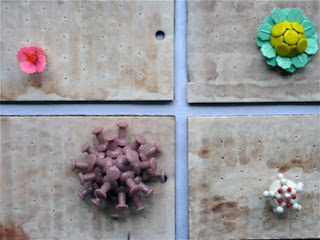 |
| Detail of “Mother Board” by Alison Foshee. |
French artist Mireille Vautier embroiders plastic bags that result in delicate, translucent, fluid forms. Vautier explores “natural phenomenon through plastic,” as in “La Mue” that mimics a snake shedding its skin.
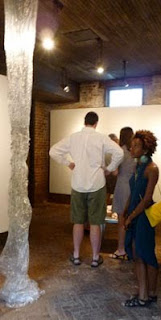 |
| Mireille Vautier’s cascading “La Mue.” |
A comic note on the more serious debate of what constitutes art.
Whether intentionally or not, Vautier’s work also raises the question of what constitutes art. As Leslie explained, she had a challenging time convincing customs to release Vautier’s artwork when it arrived from France. Customs personnel asserted that since it was not on a canvas it was not art. At least not according to their classification system. Customs released it only after the classification for her work was changed to sculpture.
For Leslie, this incident highlights how our society continues to struggle with understanding what constitutes art or how it should be classified. She hopes that the works in Not Biodegradable will help to expand our notion of art.
NOT BIODEGRADABLE
Curated by Leslie Kneisel
Artists include: Alison Foshee, David Grant, Mery Lynn McCorkle, Jon Rajkovich, Shirley Tse, Mireille Vautier
Exhibition is currently on view until September 4, 2010.
